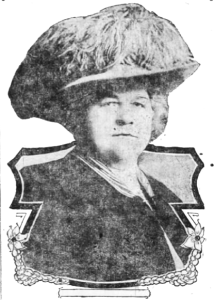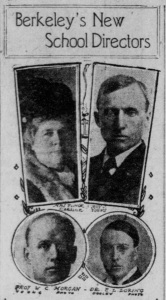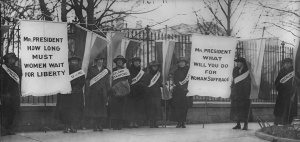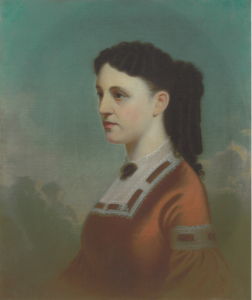Watch as video or read below.
The Nineteenth Amendment, granting national suffrage for women, was adopted on August 26, 1920, making 2020 the Centennial of its passage. We don’t know how the builders of our two historic structures, John Wornall and Alexander Majors, would have felt about the Nineteenth Amendment, as both died before its passage, in 1892 and 1900, respectively. However, Alexander Majors’ youngest daughter Elinor took a leading role in fighting for women’s suffrage in California and the larger United States.

Elinor was born in Nebraska City in 1863, two years after the failure of her father’s venture with the Pony Express and the bankruptcy of his freighting businesses. Interestingly, Majors specific reason for going into freighting in 1848 was, according to his memoirs, he had “daughters who were to be clothed and educated.” He certainly succeeded in the case of Elinor, who attended Napa Ladies Seminary in Napa, California, which offered math, English, Latin, French, Italian, science, music, and painting to its students.
She married at the age of 18 to Albert Carlisle, a successful stationer and printer in San Francisco. Like her father, she jumped into the business world with few reservations, first designing the company’s logo and then serving as the company’s president after the death of her husband in 1904. She was 41 years old.
Following her husband’s death, she threw herself into “women’s clubs” in Berkeley, California. Women’s clubs in the nineteenth and early twentieth centuries were more than just social gatherings. They gave women a way to influence social reforms at a time when women had little political power. Elinor was especially focused on issues directly affecting women and children, joining groups like the Child’s Welfare League, the Women’s Health Committee, and the Berkeley Women’s Club.
Elinor was elected to the Berkeley Board of Education in 1909, making her the first woman to serve that role. Her win was especially impressive because women had not yet achieved suffrage in California; she received the votes of men while running a campaign devoted to the needs of mothers and children. Her campaign gave women in Berkeley the unique opportunity to participate in the political process, most for the first time. Over 700 women volunteered for her campaign: canvassing, designing flyers, and organizing rallies.

Elinor frequently butted heads with the otherwise all male Board of Education. At one meeting in 1910, she said, “Not one of members of this board has shown the least interest in the social side of education of the young and I for one don’t propose to stand for it. Not one of you men knows the slightest thing about it. … As long as I am a member of this board I intend to advocate what [mothers] want, and I shall not be dominated by any member of this board.” One another occasion, she referred to board members across the state – almost entirely men – as feeble minded idiots.
Her fiery rhetoric extended to women’s suffrage. She first entered the fight for the vote in 1896, meeting Susan B. Anthony that year. “The quickening of the spirit in behalf of women will break out into a wild flame if the men are not careful,” she declared in 1909. Using her rare position as a woman in elected office, Elinor gave speeches at pro-suffrage conferences and rallies throughout the state. She encouraged women to be informed and outspoken, saying, “first, watch legislation everywhere; second, express yourself.”
Women in California won the right to vote in 1911 with the passage of California Proposition 4. After the victory, Elinor immediately devoted herself to the national cause. She became a member of the National Women’s Party serving on the National Committee of State Chairmen. Although there is no evidence Elinor ever participated, the National Women’s Party picketed the White House from 1917-1919 during the “Silent Sentinels” protests. Throughout this vigil, nearly 2,000 women were harassed, arrested, beaten, and jailed by local authorities.
The party played a critical role in the passage of the Nineteenth Amendment in 1920, which enfranchised 26 million American women. The Amendment failed to fully enfranchise many minority women, including Black and Native American women, who were kept from voting by state constitutional loopholes. It was not until 1962 that Native Americans could vote in all 50 states and 1965 when the Voting Rights Act was passed, which prohibited racial discrimination and fully enfranchised Black Americans.

An interesting foil for Elinor can be found in John’s third wife Roma Johnson Wornall. Despite Elinor being Alexander Majors daughter and Roma being John Wornall’s wife, the two women were contemporaries. Elinor was born in 1863 and died in 1932 at the age of 69. Roma was born in 1846 and died in 1933 at the age of 87.
Like Elinor, Roma was also extremely involved in women’s clubs, especially after the death of her husband when she was in her 40s. Neither woman remarried, but rather threw their energy into the community. Unlike Elinor, Roma seemed to savor the social side of club work, often throwing elaborate parties. She was particularly involved in the United Daughters of the Confederacy, or UDC, which raised funds for Confederate monuments, provided aid to Civil War veterans, and hosted various scholarship competitions and other events to educate about the “old South”, a version of history we know to be romanticized and often inaccurate.
We don’t know how Roma felt about women’s suffrage, and there were some both pro-suffrage and anti-suffrage movements within the UDC. She certainly was not active in the cause.

The differences between these two women may have been both cultural and familial. Although born in Nebraska, Elinor spent most of her life in California. The earliest women’s suffrage victories were in the West. Wyoming granted women the right to vote in 1869, followed by Colorado in 1893, and Utah and Idaho in 1896. Roma, on the other hand, was raised in Howard County, Missouri, known as “Little Dixie” because of its cultural similarities to the South.
Elinor had one sister, five half-sisters and three daughters of her own. Roma had one sister and no female children. Roma may have seen less of a pressing urgency for women’s suffrage with no daughters to benefit. Roma was also most likely surrounded by men who were either against or indifferent to votes for women. Her husband John was a lifelong Democrat, a party which at the time tended to oppose women’s suffrage bills.
Alexander Majors, on the other hand, while seemingly silent on women’s suffrage, was a member of the Populist Party, which typically aligned itself with suffrage movements and welcomed women into the political process. Majors would have probably been considered somewhat progressive during his later life.
It’s interesting that two women who led such similar lives in many ways – wealthy, educated women born in the Midwest who were married and widowed young and threw themselves into club work in their later lives – could be so different in their views.
